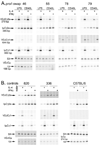The role of germline promoters and I exons in cytokine-induced gene-specific class switch recombination
- PMID: 21131417
- PMCID: PMC3059604
- DOI: 10.4049/jimmunol.1003108
The role of germline promoters and I exons in cytokine-induced gene-specific class switch recombination
Abstract
Germline transcription precedes class switch recombination (CSR). The promoter regions and I exons of these germline transcripts include binding sites for activation- and cytokine-induced transcription factors, and the promoter regions/I exons are essential for CSR. Therefore, it is a strong hypothesis that the promoter/I exons regions are responsible for much of cytokine-regulated, gene-specific CSR. We tested this hypothesis by swapping the germline promoter and I exons for the murine γ1 and γ2a H chain genes in a transgene of the entire H chain C-region locus. We found that the promoter/I exon for γ1 germline transcripts can direct robust IL-4-induced recombination to the γ2a gene. In contrast, the promoter/I exon for the γ2a germline transcripts works poorly in the context of the γ1 H chain gene, resulting in expression of γ1 H chains that is <1% the wild-type level. Nevertheless, the small amount of recombination to the chimeric γ1 gene is induced by IFN-γ. These results suggest that cytokine regulation of CSR, but not the magnitude of CSR, is regulated by the promoter/I exons.
Figures






Similar articles
-
Germline transcription and switch recombination of a transgene containing the entire H chain constant region locus: effect of a mutation in a STAT6 binding site in the gamma 1 promoter.J Immunol. 2004 Nov 1;173(9):5531-9. doi: 10.4049/jimmunol.173.9.5531. J Immunol. 2004. PMID: 15494502
-
Transgenes of the mouse immunoglobulin heavy chain locus, lacking distal elements in the 3' regulatory region, are impaired for class switch recombination.PLoS One. 2013;8(2):e55842. doi: 10.1371/journal.pone.0055842. Epub 2013 Feb 8. PLoS One. 2013. PMID: 23409061 Free PMC article.
-
Germline transcription and recombination of a murine VDJmudeltagamma1 transgene.Int Immunol. 1998 Aug;10(8):1027-37. doi: 10.1093/intimm/10.8.1027. Int Immunol. 1998. PMID: 9723688
-
Accessibility control and machinery of immunoglobulin class switch recombination.J Leukoc Biol. 2003 Mar;73(3):323-32. doi: 10.1189/jlb.0702339. J Leukoc Biol. 2003. PMID: 12629145 Review.
-
The molecular events in heavy chain class-switching.Semin Immunol. 1989 Sep;1(1):65-77. Semin Immunol. 1989. PMID: 15630960 Review.
Cited by
-
Unique contribution of IRF-5-Ikaros axis to the B-cell IgG2a response.Genes Immun. 2012 Jul;13(5):421-30. doi: 10.1038/gene.2012.10. Epub 2012 Apr 26. Genes Immun. 2012. PMID: 22535200 Free PMC article.
-
Physiology of the read-write genome.J Physiol. 2014 Jun 1;592(11):2319-41. doi: 10.1113/jphysiol.2014.271130. J Physiol. 2014. PMID: 24882816 Free PMC article. Review.
-
sciCSR infers B cell state transition and predicts class-switch recombination dynamics using single-cell transcriptomic data.Nat Methods. 2024 May;21(5):823-834. doi: 10.1038/s41592-023-02060-1. Epub 2023 Nov 6. Nat Methods. 2024. PMID: 37932398 Free PMC article.
-
Enhancement of antibody class-switch recombination by the cumulative activity of four separate elements.J Immunol. 2011 Nov 1;187(9):4733-43. doi: 10.4049/jimmunol.1101808. Epub 2011 Sep 26. J Immunol. 2011. PMID: 21949022 Free PMC article.
References
-
- Stavnezer J. Molecular processes that regulate class-switching. Curr.Topics Micro.Immunol. 2000;245:127–168. - PubMed
-
- Cogne M, Birshtein BK. Regulation of class switch recombination. In: Honjo T, Alt FW, Neuberger MS, editors. Molecular Biology of B Cells. London: Academic Press; 2004. pp. 289–305.
-
- Bergstedt-Lindqvist S, Sideras P, MacDonald HR, Severinson E. Regulation of Ig class secretion by soluble products of certain T-cell lines. Immun.Rev. 1989;78:25–50. - PubMed
-
- Snapper CM, Paul WE. Interferon-γ and B cell stimulatory factor-1 reciprocally regulate Ig isotype production. Science. 1987;236:944–946. - PubMed
Publication types
MeSH terms
Substances
Grants and funding
LinkOut - more resources
Full Text Sources
Molecular Biology Databases

